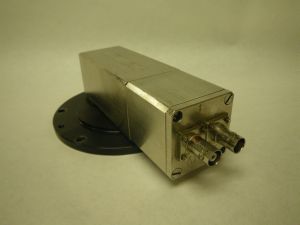
McPherson Model 654 Side-on Photomultiplier Tube
The photomultiplier tube (PMT) is among the most popular photosensitive devices in use today. Various tube types and treatments permit use of these detectors from the Extreme Vacuum Ultraviolet (EUV) through the Visible and into the near Infra-Red. Featuring large photosensitive areas, secondary emission multiplication, low dark noise and fast time response - photomultipliers are ideal for a broad range of spectroscopy applications.
The Model 654 provides the user with a light tight housing for mounting 1 1/8" (28-mm) side-on type PMT's. The housing is equipped with RF shielding and has connectors for current output and high voltage (HV) input. Some models are equipped for VUV operation. All 654 assemblies are provided with a socket for a specified tube. Tubes are specified separately.
| Type | Range, nm | Peak, nm | Max. Vdc | Sensitivity, uA/lm | Typ Amplification | Rise Time | Transit Time |
| 1P21 | 300 - 650 | 400 | 1250 | 40 | 3 x 10^6 | 2.2 ns | 22 ns |
| 1P28 | 185 - 650 | 340 | 1250 | 40 | 4.8 x 10^5 | 2.2 ns | 22 ns |
| R406 | 400 - 1100 | 730 | 1500 | 20 | 2 x 10^5 | 2 ns | 22 ns |
| R928 | 185 - 930 | 400 | 1250 | 250 | 1 x 10^7 | 2.2 ns | 22 ns |
| R955 | 160 - 900 | 400 | 1250 | 200 | 1 x 10^7 | 2.2 ns | 22 ns |
| Part Number | Description |
| 8105-0654-0 | Model 654 Atmospheric use - for 1 1/8" PMT's. Provided with a mounting flange fitting McPherson slits. Requires selection of PMT. |
| 8105-0654-1 | Model 654 Vacuum use - for 1 1/8" PMT's. Provided with a mounting flange fitting McPherson slits and a scintillator coated window for use in the vacuum ultraviolet. Requires selection of PMT |
| 8446-1003-0 | Replacement Sodium Salicylate coated window for Model 654 detector assembly. |